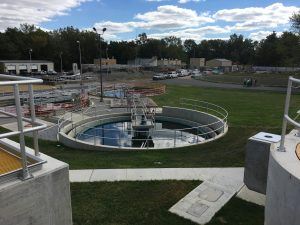Chelsea Schneider, Municipal Innovations Specialist, Aim
 Monticello is celebrating recently-completed upgrades to its wastewater treatment plant, with innovative features and additional capacity that position the northern Indiana city for economic development and growth.
Monticello is celebrating recently-completed upgrades to its wastewater treatment plant, with innovative features and additional capacity that position the northern Indiana city for economic development and growth.
The project improved the plant to a Class 3 facility, increasing its average capacity to 1.6 million gallons per day with a 3.6 peak.
The added capacity means the project’s positive influences will extend far beyond the plant. Consider this: The upgraded plant can handle Monticello adding up to 1,400 additional single-family homes.
“It gives us the capacity if another Ball Corporation wanted to come to town, they could build and tap into us without us having to do a thing yet. Even the jobs that would come with it and people hopefully moving here, it would be able to take all of that as well,” said Adam Downey, the city’s wastewater plant superintendent. “This makes us ready for them.”
In designing the plant’s innovative features, Monticello didn’t just consider its regulations, but looked at regulations for other places around the country. The result: Monticello’s system produces cleaner water than the plant previously produced by providing for total nitrogen removal. Typically water released by a treatment plant still contains nitrates, which are not toxic to fish but still have a fertilizer value. Monticello’s plant goes a step further by completely removing the substance from the water through converting it to nitrogen gas.
“It’s a whole new realm in the wastewater field,” Downey said of the total biological nutrient removal system. “What I’m wanting to show is that it can be done.”
Among other innovative features, the plant boasts disc-style tertiary filters, a newer form of ultraviolet disinfection and is expected to lower the number of combined sewer overflow events the city experiences.
“It also allows us to reduce energy demand by manipulating the processes. We are reducing chemicals. We are reducing the impact on the water body. We are reducing energy demand,” he said. “We are looking forward to fully realizing the impacts of the plant over the next couple months.”
The project was designed by Wessler Engineering and constructed by Reynolds Construction.
